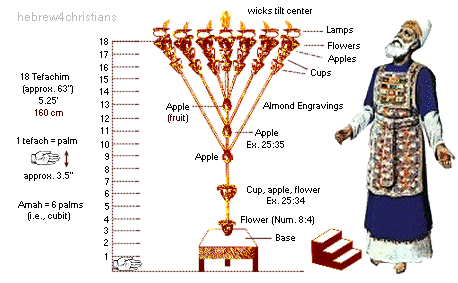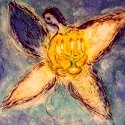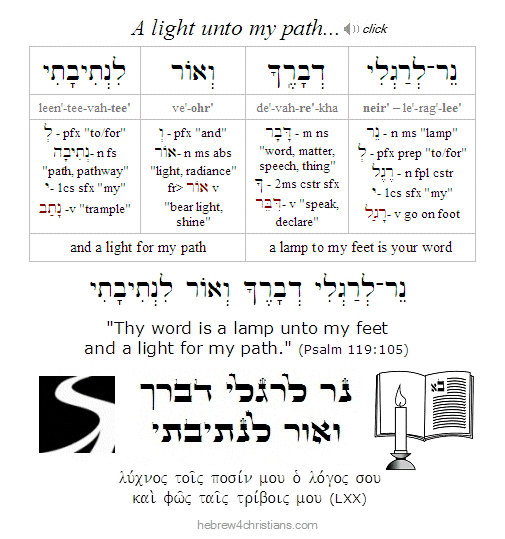|
The holy menorah (מְנוֹרָה) was formed from one piece of pure beaten gold weighing 3,000 shekels of silver (nearly 100 pounds). It was a highly decorative work that had seven branches (with seven lamps), nine flower blooms, eleven fruits, and twenty two cups. According to the Talmud, the menorah measured eighteen tefachim (i.e., "palms") in height (from the base to the start of the lamps), or roughly 5.25 feet. It is called the "lamp of God" (נֵר אֱלהִים) in the Scriptures (1 Sam. 3:3).
 |
The "lamp of God" was to be made by hammering a single piece of solid gold into shape (Exod. 25:36). Note that the word translated "hammered" or "beaten" (מִקְשָׁה) comes from the word for "difficult" in Hebrew (קָשֶׁה). According to midrash, the method for constructing the menorah was difficult for Moses to comprehend, so the LORD first showed him one in the fire and told him: "This is how you will make it." Moses was unable to do so, however, so the LORD told him to take a block of gold and have Betzalel (the carpenter from Judah) throw it into the fire. After a flash of dazzling light, a glorious menorah came out formed by God Himself.
Details of the Menorah
Although the details have been discussed (and debated) in the Talmud and related Jewish literature, the following are considered to be reliable details regarding the construction and function of the menorah. Refer to the illustration (above) for more information:
- Seven lamps (i.e., nerot: נֵרוֹת). The menorah had seven lamps, one lamp on top of the middle stem and one on top of each of its six branches. Each lamp was made of the same gold used to form the rest of the menorah. The lamps were "boat shaped" with pointed ends that faced the center lamp. The center lamp, however, resembled a basin. Each lamp had a cover on it with a hole in the middle for the oil. The wicks were positioned by either bending them toward the center or by clamping them down between the bowl and the cover. The lamps themselves were lit daily, "from evening until morning," from right to left (Exod. 27:21). According to the Talmud (Shabbat 22b), each lamp held about 9 ounces of the purest olive oil, sufficient to burn throughout the night. Wicks were created from worn-out garments of the priests.
- Seven branches (i.e., kanim: קָנִים, from קָנֶה, a "reed" or "stalk"). The middle branch (or "stem") ascended straight up from the center of the base, and the six branches emerged from three "apples" (or fruit) proportionately located on the stem. Two branches extended diagonally from each side of the apple until they reached the exact height of the middle stem. Unlike modern depictions of the menorah, it is thought that the branches were all straight (yashar), not curved. In that sense, the menorah itself resembled a tree, just as the Torah is referred to as a Tree of Life (עֵץ־חַיִּים). According to the Talmud, the height of the menorah, from base to the end of the branches, was 18 "handbreadths" (i.e., tefachim: טְפָחִים), or roughly 63 inches (160cm). The first three tefachim were the base itself. The other elements (cups, buds, and flowers) were then placed up the tree.
- Nine Flowers (i.e., perachim: פְּרַחִים) These were ornamental parts intended to beautify the menorah. According to Targum Yonathan, the flowers were similar to roses. The flowers appeared at the top of each branch, just before the lamps (the other two occurred on the main stem, including one at the base of the menorah). According to Tosofot, all the ornaments of the menorah measured one tefach in height (i.e., 3.5" or the width of a handbreadth), except for the combined flower/cup/apple that appeared on the stem at tefach 6.
- Eleven fruits (i.e., kaftorim: כַּפְתּוֹרִים) These were functional ornamentations that protruded on the stem and formed the start of the pairs of branches for the menorah. The branches would extend outward from the top of the three fruits on the main stem, and also appeared at the top of each branch as well. The Talmud (Menachot 28b) states they were shaped like apples. They are sometimes likened to the "buds" that develop into fruit. All of the apples had almond decorations engraved on them.
- Twenty-two cups (i.e., gevi'im: גְבִעִים). The "goblets" or "flower cups" were really chalice-like containers used to hold larger quantities of liquid that resembled almond buds (Exod. 25:33; Jer. 35:5). They are likened to "stems" that supply the liquid for the blossoms and fruit. According to Rashi, the cups resembled long and narrow tubes rather than flower cups. There were three cups located at the top of each branch, and an extra cup located lower on the main stem.
- One base (i.e., yarech: יָרֵךְ) with three legs. The base was either square or rectangular in shape and made of hammered pure gold. A flower that adorned its top (Exod. 25:31; Num. 8:4). The exact dimensions of the base are not stated. The Talmud (Menachot 28b) says that the base had three legs that rose three tefachim high (i.e., approx. 10.5").
- Various Utensils (i.e., kelim: כֵּלִים). In addition to the menorah itself, "utensils for oil" (כְּלֵי שַׁמְנָהּ) were created (Num. 4:9). These included tongs (to place/remove the wicks), trays, and spoons to remove ashes from the wicks (Exod. 25:38). In addition, a three-stepped platform was placed in front of the menorah for kindling the wicks and cleaning the lamps. Like all other utensils of the Mishkan, these items were made out of pure gold.
As mentioned above, the lamps of the menorah were lit daily, "from evening until morning," starting from the central lamp (the shamash) and then moving right to left (Exod. 27:21). According to the Talmud (Shabbat 22b), while all the lamps received the same amount of olive oil, the "westernmost" lamp (according to Rashi, the center lamp, due to its orientation) miraculously never ran out of oil, even though it was kindled first in the sequence. In other words, when Aaron would rekindle the lamps every evening, he found the shamash still burning, so he simply refilled it with oil and trimmed its wick. This miracle is also said to have occurred during the Temple period, though it abruptly ended about 40 years before the destruction of the Second Temple (c. 30 AD), after the death of Yeshua the Messiah, the true Servant and Branch of the LORD. As it is attested in the Talmud: "Our Rabbis taught: During the last forty years before the destruction of the Temple the lot ['For the Lord'] did not come up in the right hand; nor did the crimson-colored strap become white; nor did the westernmost light shine" (Yoma 39a).
After the death and resurrection of Yeshua, the parochet of the Temple was rent asunder and the miraculous center light of the menorah began to shine throughout the whole world. "God is light" (1 John 1:5); in His light we do see light (Psalm 36:9). "For God, who said, "Let light shine out of darkness," has shone in our hearts to give the light of the knowledge of the glory of God in the face of Yeshua the Messiah" (2 Cor. 4:6).
נֵר־לְרַגְלִי דְבָרֶךָ וְאוֹר לִנְתִיבָתִי
neir - le·rahg·lee · de·vah·re'·kha · ve·ohr · leen·tee·va·tee'

" Your word is a lamp to my feet and a light for my path "
(Psalm 119:105)


The 49 Gates of Torah
According to the Malbim, the Menorah itself is said to reveal the light of the Torah. These are sometimes called the "49 Gates of Torah." The seven branches represent the first seven words (i.e., verse) of Genesis. 1:1; the eleven fruits represent the first eleven words of of Exodus 1:1; the nine flowers represent the nine words of Leviticus 1:1; and the twenty two cups represent the twenty two words of Deuteronomy 1:1. But what about the Book of Numbers? The seventeen words of Numbers 1:1 refer to the seventeen tefachim (handbreadths) of the Menorah's height (excluding the lamps on the top).
The Hidden Light of the World
The light from the menorah is a spiritual light. It was not seen from the outside of the Tabernacle, but only while inside the holy chamber, before the holy place of sacrificial atonement. It enabled service to God to be performed, though it was not a light to be used for profane purposes. Notice that the six lamps faced the central lamp -- a picture of Yeshua, the Light of the World whose arms and legs were "hammered" for our sins.... He is the suffering servant (shamash) who lightens everyone in the world. He is the center, the supporting trunk for the other branches (John 15:5).
The light itself came from the burning of pure olive oil - a symbol of anointing and the Holy Spirit (רוּחַ הַקּדֶשׁ). It was kindled by the hand of a man of peace and humility. Likewise, when we are given light to behold the sacrifice of Yeshua for our atonement (כַּפָּרָה), we are filled with the divine light (John 8:12; 1 John 1:7, Eph. 5:8). When we come to the cross, we can behold the truth of God's unfailing love that draws us to be united with Him.
|





